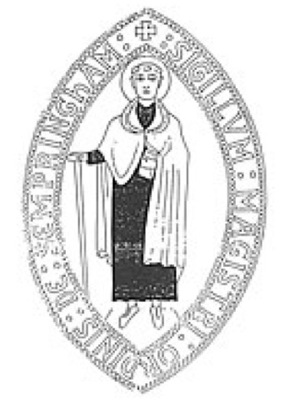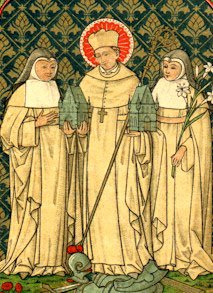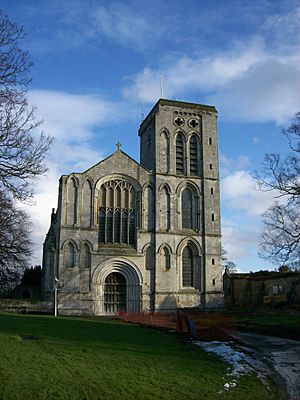Gilbertine Order facts for kids
The Gilbertine Order was a special group of Canons Regular started around 1130 by Saint Gilbert. He founded it in Sempringham, Lincolnshire, where he was a parish priest. This was the only English religious order ever created. It ended in the 1500s when King Henry VIII closed down many monasteries. However, some people have tried to bring the Gilbertine spirit back in recent times.
Contents
How the Order Started
Gilbert first created a community for women who wanted to live a quiet, religious life. In 1131, he welcomed seven women he had taught in the village school. He based their way of life on the Cistercian Rule, which is a set of rules for monks and nuns.
Gilbert built special rooms and a cloister (a covered walkway) for them next to the church in Sempringham. He gave them rules about being pure, humble, obedient, and kind. Their daily needs were passed to them through a window by other girls.
Later, the serving maids who helped the nuns also wanted to join. So, Gilbert added lay sisters to the community. Eventually, he also added lay brothers to work in the fields. In 1139, the order opened its first new house on an island called Haverholm.
Each Gilbertine house became like four communities in one:
- Nuns
- Canons (priests)
- Lay sisters
- Lay brothers
More and more new houses were built over the years.
In 1147, Gilbert traveled to Continental Europe to ask the Cistercian Order for help. They said no because they felt they couldn't manage houses for both men and women. But Pope Eugene III stepped in. He asked Saint Bernard of Clairvaux to help Gilbert write rules for his new order. These rules mixed ideas from both the Benedictine and Cistercian ways of life. Pope Eugene then named Gilbert the first Master of the Gilbertine Order. Gilbert returned to England in 1148. He finished setting up the order by adding canons (priests) to serve the community and help with managing everything.
What They Wore
The clothes worn by members of the Gilbertine Order were called "habits." They were different for each group:
Nuns' Habits
The Nuns wore a black tunic (a long dress) and a black scapular (a piece of cloth worn over the shoulders). They also had a black head-dress made of lamb's wool and a rough black cloth veil.
Sisters' Habits
The Sisters (lay sisters) wore a dark tunic but no scapular. They also had a sheepskin cloak and a long hood.
Canons' Habits
The Canons Regular (priests) wore a black cassock (a long coat). Over this, they wore a white hooded cloak lined with lamb's wool. Their shoes were made of red leather. When they worked, they used a scapular. In church, they wore a white cowl (a large hood).
Brothers' Habits
The Brothers (lay brothers) wore a dark tunic with a dark cloak. This cloak was lined with rough animal skins. In church, they wore a cloth cowl that reached their heels.
Priory Layout
Every Gilbertine priory (their monastery) had one church. This church was divided into two parts by a wall. The nuns had the larger part, and the canons had the smaller part. The canons would only join the nuns in the larger part to celebrate Mass. Usually, the nuns' buildings were to the north of the church, and the canons' living areas were to the south.
The Middle Ages
The Gilbertine Order was always popular in England and Wales. It even became the home for the last young daughters of the Welsh royal family after their family was defeated in the 1280s. One of these was Gwenllian, who lived at Sempringham Priory. A monument to her was put near the priory site in the 1990s.
Many English kings gave the order gifts and special permissions. However, the order often had money problems. By the late 1400s, the order was very poor. King Henry VI even said that all their houses didn't have to pay taxes. But he couldn't make future kings do the same.
The End of the Order
By the time of the Dissolution (when King Henry VIII closed down monasteries), there were 26 Gilbertine houses. Only four of these were considered "greater houses" because they earned more than £200 a year.
After the Dissolution of the Lesser Monasteries Act in 1536, most of these houses gave up their land to King Henry VIII in 1538 without a fight. They said they surrendered "of their own free will." Each nun and canon then received money for the rest of their lives.
The last leader of the order, Robert Holgate, tried to save them for a few years. Malton Priory, one of the smaller Gilbertine houses, was the last to surrender in December 1539. Sempringham Priory, which was a larger house, had already surrendered in 1538. Holgate later became an important church leader, the Archbishop of York.
The Gilbertines were the only religious order that was purely English (except for one short-lived house in Scotland). Because of this, their closing down meant their permanent end.
What Remains Today
Not much of the Gilbertine Order's work has survived. Only about 15 handwritten books are still around, from just five of their houses. Some other writings are known to be by Gilbertines, but the original copies are gone.
The remains of one Gilbertine monastery, Malton Priory, are now part of the local church in Malton. It was built around 1150 and, even though it has been damaged over time, what's left is still impressive. The original Priory at Sempringham was destroyed, but the nearby church of St Andrew still stands. You can still see some old decorations there.
The remains of Mattersey Priory are now looked after by English Heritage, a group that protects historical sites.
In 2001, a TV show called Time Team dug up a Gilbertine monastery in Chicksands, Bedfordshire. The show was broadcast in 2002.
Modern Attempts to Revive the Order
Oblates of St Gilbert
In 1983, after celebrations for Gilbert's 900th birthday, some people in England wanted to keep his memory alive. They started a new group called the Oblates of St Gilbert. Their goal is to promote the Gilbertine way of quiet prayer and to encourage the study of Gilbert and his order.
The Companions of St Gilbert of Sempringham
Another group, The Canons Regular of St Gilbert of Sempringham, started in Canada in 2017. However, they decided in 2019 that a full restoration of the order wasn't possible. Now, a group called The Companions of St Gilbert of Sempringham continues to share Gilbertine spirituality.
In Popular Books
The detective novel The Beautiful Mystery (2012) by Louise Penny is set in a made-up Gilbertine abbey in Quebec, Canada.
See also
- Category:Gilbertine nunneries
- Category:Gilbertine monasteries
- Anchorite




